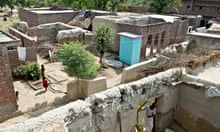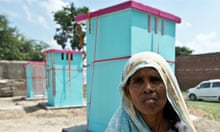Close to one in five people living in towns, cities and megacities across the world do not have access to a safe, basic toilet, according to WaterAid.
Some 600 million urban dwellers globally rely on a humiliating and haphazard array of the only services available to them in slums: filthy and crowded communal toilets, or rudimentary pit or bucket latrines that fail to meet minimum standards of hygiene, safety or privacy. A further 100 million people in cities do not even have access to these services and are forced to defecate in the open, using railway tracks, roadsides and even plastic bags dubbed “flying toilets”, the report found.
WaterAid’s Overflowing Cities report ranks developing countries, where the majority of current population growth is happening, according to how they are accommodating the basic needs of urban dwellers. It highlights diseases like Ebola, which originated in a remote rural community in Guinea and spread across towns and borders to kill more than 11,000 worldwide, and cholera, both carried via human excrement and fluids, as reminders of how devastating the effect of poor sanitation can be.
Liberia, one of the three west African countries at the heart of the Ebola epidemic, is ranked fourth worst in the world for the high proportion – 27% – of city dwellers practising open defecation.
India comes top of WaterAid’s list of countries with the largest number of urban dwellers without adequate toilets – some 157 million people in total, 41 million of whom defecate in the open. Although the Indian government has prioritised sanitation, the sheer scale of people migrating from rural areas to India’s cities has meant urban populations are expanding at a faster rate than such basic infrastructure is being built. As a result, the country has 68,000 preventable child deaths a year from diarrhoeal diseases, the report found.
China, which also has a massive rate of rural to urban migration, is the second worst, with 104 million people without safe sanitation.
However, WaterAid also ranks China top of the “most improved” countries for reaching the highest number of people in urban areas with safe, private toilets. The state has managed to build sanitation facilities faster than the pace of new arrivals, providing more than 329 million people since 2000 with urban sanitation systems, outpacing population growth by 9 million, it said. Brazil, North Korea, Vietnam and Pakistan were also in the charity’s “most improved” top 10.
Barbara Frost, WaterAid’s chief executive, said: “For the first time in history, more people around the globe are now living in cities. Cities should be a place for sustainable lifestyles offering healthy living, good infrastructure, wellbeing and economic growth. But the reality is that one person in every five living in a town or city today does not have access to a toilet or good sanitation and many live in poverty in overcrowded, rapidly expanding informal settlements.
“Not only does this lead to a lack of dignity for women and girls and health risks to poor families, this lack of sanitation also threatens the health and security of all city dwellers and leads to pollution of rivers and water sources. This World Toilet Day, we are calling on national leaders to deliver on their promises to meet the UN’s global goal six to ensure access to safe water and sanitation. Everyone has the right to affordable access to these basic services that will lead to better lives and drive prosperity.”
Urban dwellers are expected to make up two-thirds of the world’s population by 2050.
Last year, the World Health Organisation and Unicef warned that a lack of progress on sanitation threatens to undermine child survival and health gains made by countries and the international community. One child dies every two minutes from diarrhoeal diseases caused by dirty water, poor sanitation and hygiene. The practice of open defecation is also linked to stunting or malnutrition, which affects 161 million children globally.
Africa’s biggest economy, Nigeria, is falling furthest behind in providing its rapidly growing urban population with toilets. For every city dweller reached with sanitation since 2000, two were left without, an increase of 31 million people in the last 15 years. India, the Democratic Republic of the Congo and Bangladesh were also included in the top 10 falling furthest behind.
The report ranks South Sudan, the world’s newest nation, as the worst country in the world for urban sanitation. An estimated 84% of those living in the war-ravaged country’s urban areas have no safe toilets, one in two urbanites practising open defecation. Ghana, despite making great advances in development, and with one of the highest GDPs in west Africa, still has 80% of its urban population with poor sanitation.
All UN member states have committed to ensuring everyone has access to basic toilets by 2030, one of the sustainable development goals.
Andrés Hueso, WaterAid’s senior policy analyst, said: “WaterAid’s latest ‘state of world’s toilets’ report has exposed several countries for failing to make progress in providing urban sanitation, despite their rapid economic growth. Often politicians prefer to invest in roads and other visible infrastructure and neglect the dirty issue of sanitation. But good sanitation is the bedrock of public health. Every town and city in the world needs to prioritise providing safe sanitation services to all the population in order to create a healthier, more sustainable future.”









